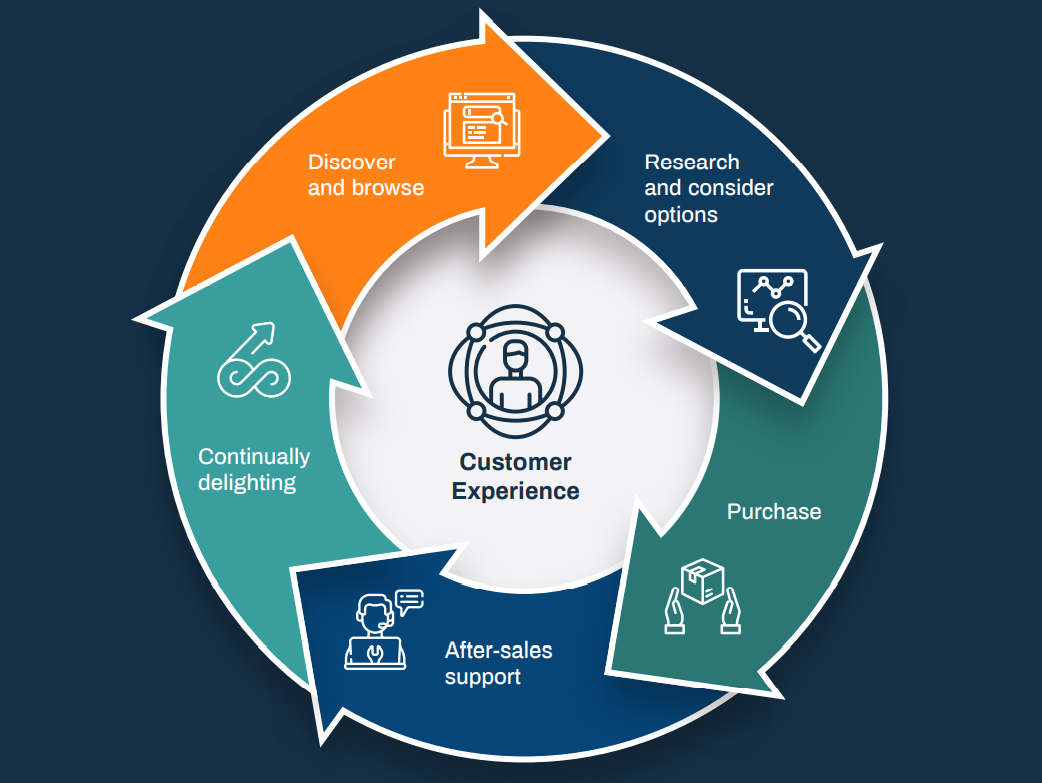Customer demands are at the forefront of every business and those demands are becoming bigger. So, it’s now more critical than ever for manufacturers to continue to grow and evolve their customer experience throughout the customer lifecycle.
In this blog, we look at the impact Industry 4.0 is having on the manufacturing industry and its ability to revolutionise customer engagement.
The typical customer lifecycle in manufacturing
The customer lifecycle is broken down into five key elements as shown in the framework:

These five areas are helpful for you to understand and contextualise your customers’ journey as we explain below.
1. Discover and browse
Customers start their journey when they discover they need a particular product or service to improve their business. At this point, they will begin to browse for a solution and come across your company.
With more of this research now being done online, up to 90% by B2B customers, it’s important for your business to offer digital capabilities. For example, an intuitive website that's designed with the customer's user experience in mind.
2. Research and consider options
Once your customer has done their research into the solutions available, they will now consider their options comparing your company with alternatives. By providing the best customer experience across many factors, such as pricing, product features, company reputation and customer service, you’re increasing the chances of the customer choosing you.
Some Industry 4.0 technologies that can help the customer during this stage are listed below:
- Augmented and virtual reality – AR and VR can help your customers visualise what your products will look like in real life without them needing to visit a showroom
- Artificial intelligence – AI can help you personalise experiences for your individual customers with little human involvement. For example, AI can take data such as a customer’s browsing and purchase history stored in your CRM and use it to offer tailored product recommendations on your website. This boosts customers convenience and helps create a smoother buying journey
- Integrated systems – if your core business systems are integrated, you’ll gain a 360-degree view of your customers which can help you deliver a personalised experience, intuitive service and more
It’s also important to consider whether your CRM system is equipped to help you provide the modern-day digital journey customers expect. The right solution, particularly when it’s integrated with your other core business systems, will help you:
- Gain a better insight into your customers’ buying journeys so optimising each stage is much easier
- Provide a more personalised customer experience by analysing the data and understanding your customer behaviour
- Create the most convenient journey with simple navigation and ensure content is relevant and contextual to your customers
- Allow employees across teams and departments access to the same, up-to-date information - this guarantees consistency as all previous conversations between your employees and customers are logged
3. Purchase
At this stage, the customer will decide on regarding the product and vendor. Manufacturers usually rely on channel partners (e.g. distributors) to develop and deliver the product to the end customer. Therefore, it’s vital you also focus on improving their customer experience and loyalty to your business.
Throughout the purchase phase, you’ll want to focus on prompt replies to customer queries, creating an effortless website experience and fast solutions to any obstacles to ensure excellent customer engagement during a sale. Some examples include:
- Partner relationship management systems (PRM) – PRM solutions can centralise insights, making it easier for you and your channel partners to collaborate and access the data you need at the right time
- Predictive analytics – if you can analyse real-time data from your partners, it’s easier for you to anticipate issues, mitigate the risks and make more informed business decisions
- RFID (radio frequency identification) and GPS trackers – this technology can help your partners (e.g. distributors) better coordinate with your customers and manage resources (e.g. scheduling crews) to optimise the overall customer experience
4. After-sales support
 Next is the after-sales support stage which - despite coming after the sale - has huge significance. Customers still expect and require excellent customer service/engagement post-purchase. Good examples of engagement at this stage include:
Next is the after-sales support stage which - despite coming after the sale - has huge significance. Customers still expect and require excellent customer service/engagement post-purchase. Good examples of engagement at this stage include:
- First purchase emails
- Follow up emails on first purchases
- Special deals on certain products
- Contacting old customers
The stage is also key to you ensuring long-term customer satisfaction and can become a profitable component of your business. Some Industry 4.0 technologies that can digitally transform it include:
- Optimising customer use – solutions (such as Microsoft Dynamics 365) that allow your fleet managers and operators to better understand resource utilisation, team productivity and maintenance requirements of individual assets in real-time
Want to read about a business that achieved this recently? Click the button below to watch our case study...
- Improving customer uptime – Internet of Things (IoT) sensors on equipment can gather vital stats such as machine performance, productivity and maintenance requirements. This can help you prevent machine failures, quickly identify root causes and remediate
5. Continually delighting
This is the point where you’re confident enough to know that your customer will keep on coming back to you for either repeat purchases or advice and support. You can continue to build customer relationships, loyalty and trust to continually delight with activities such as:
- Frequent email newsletters
- Taking on board customer feedback to improve your products and services
- Ensuring that you’re proactively booking any appointments ahead of schedule
How can manufacturers keep up?
The decision to adopt new technology is not one to be taken lightly. But with some planning and preparation, you can find the right tools you need to exceed customer expectations and bring more value to your business.
To find out more about how to improve customer engagement in the manufacturing industry, follow the link to our guide below.


